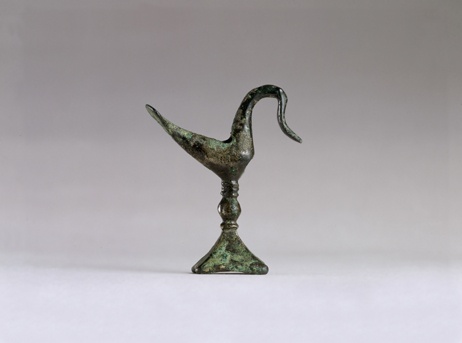
Bronze
H: 4.8 cm
Provenance: no indication
Workshop undetermined
End of Late Geometric II. 715-700 B.C.
Ex collection:
A. Moretti, Lugano (received as gift from)
Solid-cast by the lost wax process with large diagonal hole for suspension from the small of the back to the front of the breast. Three herring-bone indents in front of spatula-shaped tail.
Condition: patina medal colour to dark green with bright green and red granular oxidization and traces of earth.
It is not possible to make a definite attribution to a school, though Zimmermann [1] would probably place it in his school of Phocis in Central Greece.
Kilian-Dirlmeier [2] puts this example in her "Corinthian-type" group, on account of the profile of the base, and more particularly under variant 3, for it has a rib below and three ribs above the spherical pearl. We agree with her grouping for nos. 973, 974 and 975 (the present example).
This duck might be a Peloponnesian [3] product from Sparta, Tegea or Argos, and if so, is to be dated between Late Geometric I and II, c. 725 B.C. This would be in keeping with Rolley's contention that all the types have a common Peloponnesian origin and were later imitated in the North [4]. But it is more likely to be from Central Greece [5]: Phocis, Locris, Boeotia [6] or even Northern Greece, Thessaly [7], whose production often takes after Central Greek or Peloponnesian types and lasts over a longer period; in this case it would certainly not be before the end of the 8th century and possibly already in the 7th.
It could have been used as an amulet, an element of a necklace or hung from the belt, since such objects have been found in graves; if found in a sanctuary, they could have been votive offerings.
Exhibited and Published:
Das Tier in der Antike, cat. no. 151.
Published:
Kilian-Dirlmeier, I.: Anhänger in Griechenland von der mykenischen bis zur spätgeometrischen Zeit, PBF XI, 2 (Munich, 1979), no. 975, p. 165, pl. 53.
1 Zimmermann, J.-L.: Oiseaux géométriques de Grèce centrale et septentrionale, Quad. ticinesi di numismatica e antichità classiche, XVII, 1988, pp. 37-53; though recently (1 December 1990), when showing him this entry and the bird, Zimmermann, upon reflection, would ascribe it to Boeotia.
2 Kilian-Dirlmeier, I.: PBF XI, 2, p. 1 adopts J. Bouzek's (Eirene 6, 1967, p. 115 ff.; 9, 1971, p. 89 ff.) terminology "Corinthian and Central Greek bird-type" and she goes on to say that it is conventionally applied in literature, though it does not point to the provenance of the individual bronzes, that there remain difficulties and uncertainties in establishing types determined by regions, place of production or stylistic particularities. Cl. Rolley, FdD V2, 1969, p. 90 ff. refutes Bouzek's classification.
3 Cf. a bird from the Argive Heraeum, Athens, National Museum 13953: Waldstein, C.: Argive Heraeum II (Boston/New York, 1905), no. 40, pl. 76 though without eyes. With eyes, there are examples from Olympia, Br. 6892: Kilian-Dirlmeier: op. cit., no. 971, p. 165 pl. 53 (in all probability made in Sparta) and very close in feeling to ours, from Tegea, see Dugas, C.: BCH 45, 1921, p. 350 ff. fig. 10,30 (though we cannot discern whether with or without eyes).
4loc. cit.
5 Cf. Delphi 2971: Rolley, Cl.: op. cit., no. 133, p. 84 pl. XXII.
6 For the pyramidal base and a somewhat comparable underside, see from Elateia, Athens, National Museum 14568, 14569, 14570: Kilian-Dirlmeier: op. cit., nos. 964, 966, 970, pp. 164-165 pl. 52.
7 For a similar example though coarser, with the tail higher than the head, whereas on ours it is lower, and on a disc instead of a pyramidal base, but with identical central shaft, see from Pherai, Athens National Museum 8279: Biesantz, H.: Die thessalischen Grabreliefs (Mainz, 1965) pl. 54 L 73 top right.